Differential roles and activation of mammalian target of rapamycin complexes 1 and 2 during cell migration in prostate cancer cells
- PMID: 31995655
- PMCID: PMC7232714
- DOI: 10.1002/pros.23956
Differential roles and activation of mammalian target of rapamycin complexes 1 and 2 during cell migration in prostate cancer cells
Abstract
Background: Mammalian target of rapamycin (mTOR) is a downstream substrate activated by PI3K/AKT pathway and it is essential for cell migration. It exists as two complexes: mTORC1 and mTORC2. mTORC1 is known to be regulated by active AKT, but the activation of mTORC2 is poorly understood. In this study, we investigated the roles and differential activation of the two mTOR complexes during cell migration in prostate cancer cells.
Methods: We used small interfering RNA to silence the expression of Rac1 and the main components of mTOR complexes (regulatory associated protein of mTOR [RAPTOR] and rapamycin-insensitive companion of mTOR [RICTOR]) in LNCaP, DU145, and PC3 prostate cancer cell lines. We performed transwell migration assay to evaluate the migratory capability of the cells, and Western blot analysis to study the activation levels of mTOR complexes.
Results: Specific knockdown of RAPTOR and RICTOR caused a decrease of cell migration, suggesting their essential role in prostate cancer cell movement. Furthermore, epidermal growth factor (EGF) treatments induced the activation of both the mTOR complexes. Lack of Rac1 activity in prostate cancer cells blocked EGF-induced activation of mTORC2, but had no effect on mTORC1 activation. Furthermore, the overexpression of constitutively active Rac1 resulted in significant increase in cell migration and activation of mTORC2 in PC3 cells, but had no effect on mTORC1 activation. Active Rac1 was localized in the plasma membrane and was found to be in a protein complex, with RICTOR, but not RAPTOR.
Conclusion: We suggest that EGF-induced activation of Rac1 causes the activation of mTORC2 via RICTOR. This mechanism plays a critical role in prostate cancer cell migration.
Keywords: PI3K/AKT/mTOR; Rac1; cell migration; mTORC1; mTORC2; prostate cancer.
© 2020 Wiley Periodicals, Inc.
Conflict of interest statement
Figures
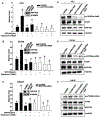
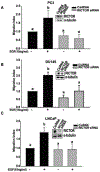

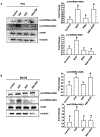
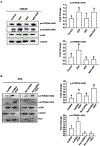


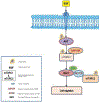
Similar articles
-
Two distinct mTORC2-dependent pathways converge on Rac1 to drive breast cancer metastasis.Breast Cancer Res. 2017 Jun 30;19(1):74. doi: 10.1186/s13058-017-0868-8. Breast Cancer Res. 2017. PMID: 28666462 Free PMC article.
-
Receptor-recognized α₂-macroglobulin binds to cell surface-associated GRP78 and activates mTORC1 and mTORC2 signaling in prostate cancer cells.PLoS One. 2012;7(12):e51735. doi: 10.1371/journal.pone.0051735. Epub 2012 Dec 14. PLoS One. 2012. Retraction in: PLoS One. 2025 Jun 5;20(6):e0325675. doi: 10.1371/journal.pone.0325675. PMID: 23272152 Free PMC article. Retracted.
-
Selective interference of mTORC1/RAPTOR protects against human disc cellular apoptosis, senescence, and extracellular matrix catabolism with Akt and autophagy induction.Osteoarthritis Cartilage. 2017 Dec;25(12):2134-2146. doi: 10.1016/j.joca.2017.08.019. Epub 2017 Sep 6. Osteoarthritis Cartilage. 2017. PMID: 28888905
-
The Role of Mammalian Target of Rapamycin (mTOR) in Insulin Signaling.Nutrients. 2017 Oct 27;9(11):1176. doi: 10.3390/nu9111176. Nutrients. 2017. PMID: 29077002 Free PMC article. Review.
-
Discrete signaling mechanisms of mTORC1 and mTORC2: Connected yet apart in cellular and molecular aspects.Adv Biol Regul. 2017 May;64:39-48. doi: 10.1016/j.jbior.2016.12.001. Epub 2017 Jan 4. Adv Biol Regul. 2017. PMID: 28189457 Review.
Cited by
-
ALYREF recruits ELAVL1 to promote colorectal tumorigenesis via facilitating RNA m5C recognition and nuclear export.NPJ Precis Oncol. 2024 Oct 25;8(1):243. doi: 10.1038/s41698-024-00737-0. NPJ Precis Oncol. 2024. PMID: 39455812 Free PMC article.
-
Dual Inhibition of mTORC1/2 Reduces Migration of Cholangiocarcinoma Cells by Regulation of Matrixmetalloproteinases.Front Cell Dev Biol. 2022 Jan 13;9:785979. doi: 10.3389/fcell.2021.785979. eCollection 2021. Front Cell Dev Biol. 2022. PMID: 35096817 Free PMC article.
-
Assessing the mechanism of fast-cycling cancer-associated mutations of Rac1 small Rho GTPase.Protein Sci. 2024 Apr;33(4):e4939. doi: 10.1002/pro.4939. Protein Sci. 2024. PMID: 38501467 Free PMC article.
-
Dual contribution of the mTOR pathway and of the metabolism of amino acids in prostate cancer.Cell Oncol (Dordr). 2022 Oct;45(5):831-859. doi: 10.1007/s13402-022-00706-4. Epub 2022 Aug 29. Cell Oncol (Dordr). 2022. PMID: 36036882 Review.
-
Rac1 promotes the reprogramming of glucose metabolism and the growth of colon cancer cells through upregulating SOX9.Cancer Sci. 2023 Mar;114(3):822-836. doi: 10.1111/cas.15652. Epub 2022 Nov 29. Cancer Sci. 2023. PMID: 36369902 Free PMC article.
References
Publication types
MeSH terms
Substances
Grants and funding
LinkOut - more resources
Full Text Sources
Medical
Research Materials
Miscellaneous

